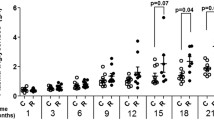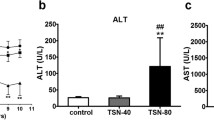Abstract
Several persistent organic pollutants are reported to be potentially associated with the risk of human diabetes that has become rapidly epidemic in China currently. 2,2′,3,3′,4,4′,5,5′,6,6′-decabromodiphenyl ether (BDE209) is commercially most important both in the production and in the use of polybrominated diphenyl ethers (PBDEs). It might bioaccumulate in wildlife and human and is the only PBDEs mixture still used today. In the present study, male adult rats treated with BDE209 (0, 0.05, 1, and 20 mg/kg) for 8 weeks were used to explore the effects of BDE209 on glucose homeostasis and possible mechanisms; 0.05 mg/kg of BDE209 induced dose-related hyperglycemia. Then, we performed the full-genome gene expression microarrays, gene ontology analysis, and pathway analysis in this group and control. BDE209 induced 1,257 liver gene transcript changes, and 18 canonical pathways were significantly enriched. Four of them were involved in immune diseases, including autoimmune thyroid disease, graft-versus-host disease, allograft rejection, and type I diabetes mellitus (T1MD), which was confirmed by the decrease in serum insulin. Subsequently, gene act network and gene co-expression network found that some MHC molecules and TNF-α were involved in T1DM pathway, which was then confirmed by the increase in serum TNF-α. Additionally, reduced glutathione and superoxide dismutase in plasma indicated that oxidative damage might partly contribute to BDE209-induced hyperglycemia. The results of this study provide some new experimental evidence that the exposure to high levels of BDE209 may contribute to the onset of diabetes in human populations. Further work needs to be done to confirm this link.




Similar content being viewed by others
Abbreviations
- BDE209:
-
2,2′,3,3′,4,4′,5,5′,6,6′-decabromodiphenyl ether
- PBDEs:
-
Polybrominated diphenyl ethers
- OH-BDEs:
-
Hydroxylated polybrominated diphenyl ether
- POPs:
-
Persistent organic pollutants
- CHOL:
-
Total cholesterol
- TG:
-
Triglyceride
- ROS:
-
Reactive oxygen species
- MDA:
-
Malondialdehyde
- GSH:
-
Reduced glutathione
- SOD:
-
Superoxide dismutase
- TNF-α:
-
Tumor necrosis factor α
- MHC:
-
Major histocompatibility complex
- T1DM:
-
Type I diabetes mellitus
- NOD:
-
Nonobese diabetic
- GO:
-
Gene ontology
- ELISA:
-
Enzyme-linked immunosorbent assays
- qRT-PCR:
-
Real-time quantitative reverse transcription polymerase chain reaction
References
Albina ML, Alonso V, Linares V et al (2010) Effects of exposure to BDE-99 on oxidative status of liver and kidney in adult rats. Toxicology 271(1–2):51–56
Barabasi AL, Oltvai ZN (2004) Network biology: understanding the cell’s functional organization. Nat Rev Genet 5(2):101–113
Bruchajzer E, Frydrych B, Sporny S, Szymańska JA (2009) Toxicity of penta- and decabromodiphenyl ethers after repeated administration to rats: a comparative study. Arch Toxicol 84(4):287–299
Carlson MR, Zhang B, Fang Z, Mischel PS, Horvath S, Nelson SF (2006) Gene connectivity, function, and sequence conservation: predictions from modular yeast co-expression networks. BMC Genomics 7:40
Delmastro MM, Piganelli JD (2011) Oxidative Stress and Redox Modulation Potential in Type 1 Diabetes. Clin Dev Immunol 2011:1–15
DIAMOND Project Group (2006) Incidence and trends of childhood Type 1 diabetes worldwide 1990–1999. Diabet Med 23(8):857–866
Draghici S, Khatri P, Tarca AL et al (2007) A systems biology approach for pathway level analysis. Genome Res 17(10):1537–1545
Dunnick JK, Brix A, Cunny H, Vallant M, Shockley KR (2012) Characterization of polybrominated diphenyl ether toxicity in Wistar Han rats and use of liver microarray data for predicting disease susceptibilities. Toxicol Pathol 40(1):93–106
Dupuy D, Bertin N, Hidalgo CA et al (2007) Genome-scale analysis of in vivo spatiotemporal promoter activity in Caenorhabditis elegans. Nat Biotechnol 25(6):663–668
EPA (2008) Toxicological review of decabromodiphenyl ether (BDE209). http://www.epa.gov/iris/toxreviews/0035tr.pdf
Gaidhu MP, Perry RL, Noor F, Ceddia RB (2010) Disruption of AMPKalpha1 signaling prevents AICAR-induced inhibition of AS160/TBC1D4 phosphorylation and glucose uptake in primary rat adipocytes. Mol Endocrinol 24(7):1434–1440
Gene Ontology Consortium (2006) The Gene Ontology (GO) project in 2006. Nucleic Acids Res 34(Database issue):D322-6
Green EA, Flavell RA (1999) Tumor necrosis factor-alpha and the progression of diabetes in non-obese diabetic mice. Immunol Rev 169:11–22
He Y, Murphy MB, Yu RM et al (2008) Effects of 20 PBDE metabolites on steroidogenesis in the H295R cell line. Toxicol Lett 176(3):230–238
Irizarry RA, Bolstad BM, Collin F, Cope LM, Hobbs B, Speed TP (2003) Summaries of Affymetrix GeneChip probe level data. Nucleic Acids Res 31(4):e15
Klocek MS, Sassani JW, McLaughlin PJ, Zagon IS (2009) Naltrexone and insulin are independently effective but not additive in accelerating corneal epithelial healing in type I diabetic rats. Exp Eye Res 89(5):686–692
Koulmanda M, Bhasin M, Hoffman L et al (2008) Curative and beta cell regenerative effects of alpha1-antitrypsin treatment in autoimmune diabetic NOD mice. Proc Natl Acad Sci USA 105(42):16242–16247
Koulmanda M, Bhasin M, Awdeh Z et al (2012) The role of TNF-alpha in mice with Type 1- and 2- diabetes. PLoS ONE 7(5):e33254
Kumar N, Kaur G, Tandon N, Mehra N (2012) Tumor necrosis factor–associated susceptibility to type 1 diabetes is caused by linkage disequilibrium with HLA-DR3 haplotypes. Hum Immunol 73(5):566–573
Langer P, Tajtakova M, Guretzki HJ et al (2002) High prevalence of anti-glutamic acid decarboxylase (anti-GAD) antibodies in employees at a polychlorinated biphenyl production factory. Arch Environ Health 57(5):412–415
Lee EKT, Choi JS, Nabanata P, Kim NY, Ahn MY, Jung KK, Kang IH, Kim TS, Kwack SJ, Park KL, Kim SH, Kang TS, Lee J, Lee BM, Kim HS (2010) Evaluation of liver and thyroid toxicity in Sprague-Dawley rats after exposure to polybrominated diphenyl ether BDE-209. J Toxicol Sci 35(4):535–545
Li C, Li H (2008) Network-constrained regularization and variable selection for analysis of genomic data. Bioinformatics 24(9):1175–1182
Lim JS, Lee DH, Jacobs DR Jr (2008) Association of brominated flame retardants with diabetes and metabolic syndrome in the US population, 2003–2004. Diabetes Care 31(9):1802–1807
National Toxicology Program (1986) NTP toxicology and carcinogenesis studies of decabromodiphenyl oxide (CAS No. 1163-19-5) in F344/N rats and B6C3F1 mice (feed studies). Natl Toxicol Program Tech Rep Ser 309:1–242
Neefjes J, Jongsma ML, Paul P, Bakke O (2011) Towards a systems understanding of MHC class I and MHC class II antigen presentation. Nat Rev Immunol 11(12):823–836
Papin JA, König M, Bulik S, Holzhütter H-G (2012) Quantifying the contribution of the liver to glucose homeostasis: a detailed kinetic model of human hepatic glucose metabolism. PLoS Comput Biol 8(6):e1002577
Patel SS, Goyal RK (2011) Prevention of diabetes-induced myocardial dysfunction in rats using the juice of the Emblica officinalis fruit. Exp Clin Cardiol 16(3):87–91
Patterson CC, Gyurus E, Rosenbauer J et al (2012) Trends in childhood type 1 diabetes incidence in Europe during 1989–2008: evidence of non-uniformity over time in rates of increase. Diabetologia 55(8):2142–2147
Prieto C, Risueno A, Fontanillo C, De las Rivas J (2008) Human gene coexpression landscape: confident network derived from tissue transcriptomic profiles. PLoS ONE 3(12):e3911
Ravasz E, Somera AL, Mongru DA, Oltvai ZN, Barabasi AL (2002) Hierarchical organization of modularity in metabolic networks. Science 297(5586):1551–1555
Roberts SC, Noyes PD, Gallagher EP, Stapleton HM (2011) Species–specific differences and structure − activity relationships in the debromination of PBDE congeners in three fish species. Environ Sci Technol 45(5):1999–2005
Shao J, White CC, Dabrowski MJ, Kavanagh TJ, Eckert ML, Gallagher EP (2007) The role of mitochondrial and oxidative injury in BDE 47 toxicity to human fetal liver hematopoietic stem cells. Toxicol Sci 101(1):81–90
Smyth GK (2004) Linear models and empirical bayes methods for assessing differential expression in microarray experiments. Stat Appl Genet Mol Biol 3:Article3
Thayer TCDM, Liu C, Chen J, Padgett LE, Tse HM, Annamali M, Piganelli JD, Moldawer LL, Mathews CE (2011) Superoxide production by macrophages and T cells is critical for the induction of autoreactivity and Type 1 diabetes. Diabetes 60(8):2144
Thompson JA, Perry D, Brusko TM (2012) Autologous regulatory T cells for the treatment of type 1 diabetes. Curr Diab Rep 12(5):623–632
Tseng L-H, Li M-H, Tsai S–S et al (2008) Developmental exposure to decabromodiphenyl ether (PBDE 209): effects on thyroid hormone and hepatic enzyme activity in male mouse offspring. Chemosphere 70(4):640–647
van Belle TL, Coppieters KT, von Herrath MG (2011) Type 1 diabetes: etiology, immunology, and therapeutic strategies. Physiol Rev 91(1):79–118
Wang C, Xu S, Lv Z, Li Y, Wang Y, Chen T (2010) Exposure to persistent organic pollutants as potential risk factors for developing diabetes. Sci China Chem 53(5):980–994
Yang H, Crawford N, Lukes L, Finney R, Lancaster M, Hunter KW (2005) Metastasis predictive signature profiles pre-exist in normal tissues. Clin Exp Metastasis 22(7):593–603
Yang W, Lu J, Weng J et al (2010) Prevalence of diabetes among men and women in China. N Engl J Med 362(12):1090–1101
Yi M, Horton JD, Cohen JC, Hobbs HH, Stephens RM (2006) WholePathwayScope: a comprehensive pathway-based analysis tool for high-throughput data. BMC Bioinformatics 7:30
Zhang JD, Wiemann S (2009) KEGGgraph: a graph approach to KEGG PATHWAY in R and bioconductor. Bioinformatics 25(11):1470–1471
Zherebitskaya E, Akude E, Smith DR, Fernyhough P (2009) Development of selective axonopathy in adult sensory neurons isolated from diabetic rats: role of glucose-induced oxidative stress. Diabetes 58(6):1356–1364
Acknowledgments
The authors wish to thank Drs. Dai Chen and Jie Zong (Novel Bioinformatics Ltd., Co, Shanghai, China) for their technical assistance in bioinformatics analysis. This work was supported by Environmental Protection Research Special Funds for Public Welfare Projects (200909054), National 973 program (2009CB941701), National Natural Science Foundation of China (81172695, 30972508), Doctoral Fund of Ministry of Education of China (20093234110002), Six talents peak project of Jiangsu province (DG216D5047), and a project funded by the Priority Academic Program Development of Jiangsu Higher Education Institutions (PAPD), China.
Conflict of interest
No competing financial interests exist.
Author information
Authors and Affiliations
Corresponding author
Additional information
Zhan Zhang and Zhen-Zhen Sun contributed equally to this work.
Electronic supplementary material
Below is the link to the electronic supplementary material.
Rights and permissions
About this article
Cite this article
Zhang, Z., Sun, ZZ., Xiao, X. et al. Mechanism of BDE209-induced impaired glucose homeostasis based on gene microarray analysis of adult rat liver. Arch Toxicol 87, 1557–1567 (2013). https://doi.org/10.1007/s00204-013-1059-8
Received:
Accepted:
Published:
Issue Date:
DOI: https://doi.org/10.1007/s00204-013-1059-8




